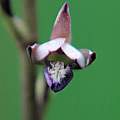Eulophia is a genus in the Orchidaceae family with over 200 species spread throughout tropical Americas, Asia and South Africa. They are characterized by being terrestrial, rarely epiphytic and are tall having globose corms, short stalks and long plicate leaves. The inflorescence is basal and can attain a length of 15' (5 meters) with a raceme of several, medium sized flowers with lateral sepals that arch upwards, a lip that is deeply concave at the base and carries longitudinal crests on its blade. There is a long foot on the column carrying two pollina with a stipe.
Eulophia aculeata (L.f.) Spreng. is a rhizomatous geophyte to 50 cm tall. It is found in grassland and fynbos from the southwestern Cape to Mpumalanga. Flowers are in a dense crowded inflorescence without a spur and are ivory to greenish, pink or purple. Photos by Cameron McMaster and Mary Sue Ittner. Photos #3-5 were taken near Maclear in January 2010.
Eulophia aculeata subsp. aculeata has small white to greenish white flowers. Photo #1 taken by Cameron McMaster. Photos #2-3 were taken January 2010 by Bob Rutemoeller and photos 4-5 were taken by Christopher Whitehouse January 2012 on the summit of Gaika's Kop.
Eulophia ensata Lindl. is found in grassland and open bushveld, often coastal, from the Eastern Cape to the Northern Province. Growing to 1 m tall, it has pleated leaves on a separate shoot and few to many pale to bright yellow flowers in a dense spike. Photos 1-4 taken by Bob Rutemoeller and Mary Sue Ittner in grassland in the Eastern Cape, January 2010. The last photo was taken by Mary Sue Ittner in the bulb room at Kirstenbosch National Botanical Garden where they obviously are flowering it successfully.
Eulophia foliosa (Lindl.) Bolus is found in grassland from the Eastern Cape to the Northern Province of South Africa. It is summer growing to 60 cm. Flowers are in a dense elongated cluster and are lime-green with the ends of the lip tinged purple or white. Photos #1 and 2 taken by Cameron McMaster at Patchwood and Satansnek Pass in the Eastern Cape. Photos #3 and 4 taken by Bob Rutemoeller at Maclear.
Eulophia herbacea Lindl. is a summer growing, winter dormant (deciduous) species native to southeast Asia. The plant in the photos is about 10 inches (25 cm) tall and the flowers are about 1 inch (2.5 cm) wide. Photos taken June 2011 by Eugene Zielinski.
Eulophia hians Spreng. syn. Eulophia clavicornis Lindl. is a rhizomatous geophyte to 80 cm tall. It is found in grassland from the Eastern Cape to tropical Africa and is very variable in size, color of the flowers, and leaf development. It has green to purplish brown sepals and white to purple or yellow petals and lip. The flowers have fleshy lip crests with peglike outgrowths almost reaching the tip of the lip. Photos by Cameron McMaster.
There are three varieties mostly differing in the details of the lip, var. hians, var. inaequalis, and var. nutans.
Eulophia hians var. nutans (Sond.) S.Thomas, syn. Eulophia clavicornis var. nutans (Sond.) A.V.Hall is found in grassland. It has fully developed leaves at flowering. The flowers are white to purple or yellow. Photos by Cameron McMaster, Bob Rutemoeller, and Mary Sue Ittner. The last four photos were taken at Maclear January 2010.
Eulophia leontoglossa Rchb.f. is widespread in Eastern southern Africa where it is found in moist to wet grassland. It is known as the Lion's Tongue or the Lion's Tooth Orchid. It has nodding white to yellow or pink tinged green sepals and petals. Tepals do not open very widely. Height range: 60-90 cm. Photos from Cameron McMaster and Mary Sue Ittner taken near Maclear January 2010.
Eulophia macowanii Rolfe is found in grassland in the Eastern Cape and KwaZulu-Natal. Leaves are found on a separate shoot and flowers are cream and brown. It grows to 40 cm tall. Photos by Cameron McMaster, Bob Rutemoeller, and Mary Sue Ittner.
Eulophia ovalis Lindl. is a deciduous rhizomatous geophyte to 69 cm tall. It is found on dry or marshy grassland and bushveld from the Eastern Cape to tropical Africa. Flowers are purple and white or cream to lilac. The lip has fleshy, peglike outgrowths. Photo by Cameron McMaster.
Eulophia parviflora (Lindl.) A.V.Hall is found in the Eastern Cape in grassland, coastal thornveld, and rocky slopes. It is pleasantly scented with brown and yellow flowers. Height range: 20-50 cm. Photo by Cameron McMaster.
Eulophia platypetala Lindl. is found in coastal renosterveld and forest clearings from the Southwestern to the Eastern Cape. Growing to 60 cm and flowering late spring, it has yellow and green flowers marked with purple-red lines in a lax raceme. Photos from the book Plants of the Klein Karoo courtesy of Jan and Anne Lise Schutte-Vlok.
Eulophia speciosa (R.Br.) Bolus is found in bushveld and open scrub in South Africa, Namibia, and Botswana. It has subterranean or partly aerial pseudobulbs and bright yellow and green flowers with purple markings. Height range: 5-6 ft. Photos by Cameron McMaster.
Eulophia streptopetala Lindl. is a robust species found in thicket or on forest margins from the Eastern Cape to tropical Africa. It has a short pseudo bulb that is partially exposed above ground. Sepals are green, mottled purplish brown and the roundish petals are yellow with the lip streaked red-brown. It is long blooming. Height range: up to 2.5 m. Photo by Cameron McMaster.
Eulophia welwitchii (Rchb.f.) Rolfe grows in grassland and marshy areas from the Eastern Cape to tropical Africa. It has stiff erect pleated leaves and pale creamy lemon to bright yellow large flowers in a dense inflorescence. The sepals and petals are not spreading. Height range: 1-3 ft. Photos 1-4 taken by Mary Sue Ittner and Bob Rutemoeller at Maclear January 2010. The first shows the habitat. The last photo was taken by Mary Sue Ittner in the bulb room at Kirstenbosch National Botanical Garden where they obviously are flowering it successfully.

















































